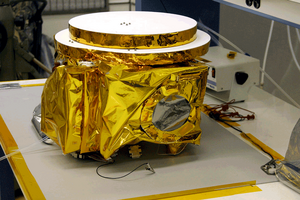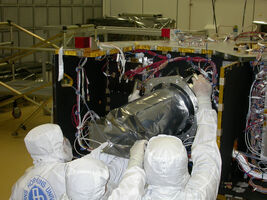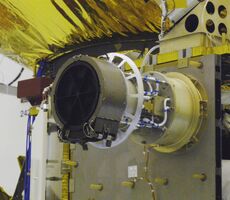Template:About Template:Italic title
New Horizons is an interplanetary space probe that was launched as a part of NASA's New Frontiers program.[2] Engineered by the Johns Hopkins University Applied Physics Laboratory (APL) and the Southwest Research Institute (SwRI), with a team led by S. Alan Stern,[3] the spacecraft was launched in 2006 with the primary mission to perform a flyby study of the Pluto system in 2015, and a secondary mission to fly by and study one or more other Kuiper belt objects (KBOs) in the decade to follow.[4][5][6][7][8] It is the fifth of five artificial objects to achieve the escape velocity that will allow them to leave the Solar System.
On January 19, 2006, New Horizons was launched from Cape Canaveral Air Force Station by an Atlas V rocket directly into an Earth-and-solar escape trajectory with a speed of about 69. After a brief encounter with asteroid 132524 APL, New Horizons proceeded to Jupiter, making its closest approach on February 28, 2007, at a distance of 69. The Jupiter flyby provided a gravity assist that increased New HorizonsTemplate:' speed; the flyby also enabled a general test of New HorizonsTemplate:' scientific capabilities, returning data about the planet's atmosphere, moons, and magnetosphere.
Most of the post-Jupiter voyage was spent in hibernation mode to preserve on-board systems, except for brief annual checkouts.[9] On December 6, 2014, New Horizons was brought back online for the Pluto encounter, and instrument check-out began.[10] On January 15, 2015, the New Horizons spacecraft began its approach phase to Pluto.
On July 14, 2015, at 11:49 UTC, it flew Template:Cvt above the surface of Pluto,[11][12] making it the first spacecraft to explore the dwarf planet.[7][13] On October 25, 2016, at 21:48 UTC, the last of the recorded data from the Pluto flyby was received from New Horizons.[14] Having completed its flyby of Pluto,[15] New Horizons has maneuvered for a flyby of Kuiper belt object 4869582014 MU,[16][17][18] expected to take place on January 1, 2019, when it will be 43.4 AU from the Sun.[16][17]
New Horizons was launched on January 19, 2006, directly into an Earth-and-solar-escape trajectory with an Earth-relative velocity of about after its last engine was shut down. Thus, the spacecraft left Earth at the greatest-ever launch speed for a man-made object. It flew by the orbit of Mars on April 7, 2006, Jupiter on February 28, 2007, the orbit of Saturn on June 8, 2008; and the orbit of Uranus on March 18, 2011. As of February 2012, its distance to Pluto is less than 10 AU[19] (more than 20 AU from Earth).
Background[]
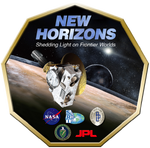
New Horizons mission logo
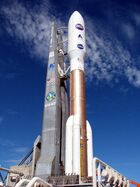
New Horizons on the launchpad
New Horizons is the first mission in NASA's New Frontiers mission category, larger and more expensive than Discovery missions but smaller than the Flagship Program. The cost of the mission (including spacecraft and instrument development, launch vehicle, mission operations, data analysis, and education/public outreach) is approximately 650 million USD over 15 years (from 2001 to 2016). An earlier proposed Pluto mission – Pluto Kuiper Express – was cancelled by NASA in 2000 for budgetary reasons. Further information relating to an overview with historical context[20] can be found at the IEEE website and gives further background and details, with more details regarding the Jupiter fly-by.[21]
The spacecraft was built primarily by Southwest Research Institute (SwRI) and the Johns Hopkins Applied Physics Laboratory. The mission's principal investigator is Alan Stern (NASA Associate Administrator, formerly of the Southwest Research Institute).
Overall control, after separation from the launch vehicle, is performed at Mission Operations Center (MOC) at the Applied Physics Laboratory. The science instruments are operated at the Clyde Tombaugh Science Operations Center (T-SOC) in Boulder, Colorado.[22] Navigation, which is not real-time, is performed at various contractor facilities, while the navigational positional data and related celestial reference frames are provided by the Naval Observatory Flagstaff Station through Headquarters NASA and JPL; KinetX is the lead on the New Horizons navigation team and is responsible for planning trajectory adjustments as the spacecraft speeds toward the outer Solar System.
New Horizons was originally planned as a voyage to what was the only unexplored planet in the Solar System. When the spacecraft was launched, Pluto was still classified as a planet, later to be reclassified as a dwarf planet by the International Astronomical Union (IAU). Some members of the New Horizons team, including Alan Stern, disagree with the IAU definition and still describe Pluto as the ninth planet.[23] Pluto's satellites Nix and Hydra also have a connection with the spacecraft: the first letters of their names, N and H, are the initials of "New Horizons". The moons' discoverers chose these names for this reason, in addition to Nix and Hydra's relationship to the mythological Pluto.[24]
In addition to the scientific equipment, there are several cultural artifacts traveling with the spacecraft. These include a collection of 434,738 names stored on a compact disc,[25] a piece of Scaled Composites SpaceShipOne,[26] and an American flag, along with other mementos.[27]
To commemorate the discovery of Pluto, one ounce of the ashes of Pluto discoverer Clyde Tombaugh are aboard the spacecraft.[28] An exploration-themed coin, a Florida state quarter, is included officially as a trim weight[29] but also as might be symbolically appropriate to pay Charon (mythology), the ferryman of the dead to the realm of Pluto. One of the science packages (a dust counter) is named after Venetia Burney, who, as a child, suggested the name Pluto after the planet's discovery.
Launch[]
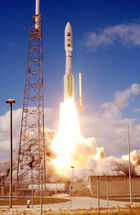
New Horizons at lift-off
The launch of New Horizons was originally scheduled for January 11, 2006, but was initially delayed until January 17 to allow for borescope inspections of the Atlas rocket's kerosene tank. Further delays related to low cloud ceiling conditions downrange, and high winds and technical difficulties — unrelated to the rocket itself — prevented launch for a further two days. The probe finally lifted off from Pad 41 at Cape Canaveral Air Force Station, Florida, directly south of Space Shuttle Launch Complex 39, at 14:00 EST on January 19, 2006.
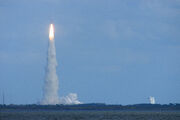
Space Launch Complex 41 during New Horizons launch
The Centaur second stage reignited at 14:30 EST (19:30 UTC), successfully sending the probe on a solar-escape trajectory. New Horizons took only nine hours to reach the Moon's orbit, passing lunar orbit before midnight EST that day.
Although there were backup launch opportunities in February 2006 and February 2007, only the first 23 days of the 2006 window permitted the Jupiter fly-by. Any launch outside that period would have forced the spacecraft to fly a slower trajectory directly to Pluto, delaying its encounter by 2–4 years.
The craft was launched by a Lockheed Martin Atlas V 551 rocket, with an ATK Star 48B third stage added to increase the heliocentric (escape) speed. This was the first launch of the 551 configuration of the Atlas V, as well as the first Atlas V launch with an additional third stage (Atlas V rockets usually do not have a third stage). Previous flights had used none, two, or three solid boosters, but never five. This puts the Atlas V 551 take-off thrust, at well over 69, past the Delta IV-Heavy. The major part of this thrust is supplied by the Russian RD-180 engine, providing 69. The Delta IV-H remains the larger vehicle, at over 69 compared to 69 of the AV-010. The Atlas V rocket had earlier been slightly damaged when Hurricane Wilma swept across Florida on October 24, 2005. One of the solid rocket boosters was hit by a door. The booster was replaced with an identical unit, rather than inspecting and requalifying the original.[30]

Launch of NASA's New Horizons Spacecraft
New Horizons probe launched from Cape Canaveral on January 19, 2006
The Star 48B third stage is also on a hyperbolic Solar System escape trajectory, and reached Jupiter before the New Horizons spacecraft. However, since it is not in controlled flight, it did not receive the correct gravity assist, and will only pass within 69 of Pluto.[31]
New Horizons is often erroneously given the title of Fastest Spacecraft Ever Launched, when in fact the Helios probes are the holders of that title. New Horizons achieved the highest launch velocity and thus left Earth faster than any other spacecraft to date. It is also the first spacecraft launched directly into a solar escape trajectory, which requires an approximate velocity of 69, plus losses, all to be provided by the launcher. However, it will not be the fastest spacecraft to leave the Solar System. This record is held by Voyager 1, currently travelling at 69 relative to the Sun. Voyager 1 attained greater hyperbolic excess velocity from Jupiter and Saturn gravitational slingshots than New Horizons. Other spacecraft, such as Helios 1 & 2, can also be measured as the fastest objects, due to their orbital velocity relative to the Sun at perihelion. However, because they remain in solar orbit, their orbital energy relative to the Sun is lower than the five probes, and three other third stages on hyperbolic trajectories, including New Horizons, that achieved solar escape velocity, as the Sun has a much deeper gravitational wellthanEarth. Template:-
Trajectory corrections and instrument testing[]
On January 28 and 30, 2006, mission controllers guided the probe through its first trajectory correction maneuver (TCM), which was divided into two parts (TCM-1A and TCM-1B). The total velocity change of these two corrections was about 18 meters per second. TCM-1 was accurate enough to permit the cancellation of TCM-2, the second of three originally scheduled corrections.[32]
During the week of February 20, controllers conducted initial in-flight tests of three onboard scientific instruments, the Alice ultraviolet imaging spectrometer, the PEPSSI plasma-sensor, and the LORRI long-range visible-spectrum camera. No scientific measurements or images were taken, but instrument electronics, and in the case of Alice, some electromechanical systems were shown to be functioning correctly.[33]
On March 9 at 1700 UTC, controllers performed TCM-3, the last of three scheduled course corrections. The engines burned for 76 seconds, adjusting the spacecraft's velocity by about 1.16 meters per second.[34]
On September 25, 2007 on 16:04 EDT, the engines were fired for 15 minutes and 37 seconds, changing the spacecraft's velocity by 2.37 meters per second.[35]
On June 30, 2010 on 7:49 EDT, mission controllers executed a fourth TCM on New Horizons that lasted 35.6 seconds.[36]
Passing Mars orbit and asteroid flyby[]
On April 7, 2006 at 10:00 UTC, the spacecraft passed the orbit of Mars, moving at roughly 21 km/s away from the Sun at a solar distance of 243 million kilometers.[37]
New Horizons made a distant flyby of the small asteroid 132524 APL (previously known by its provisional designation, 2002 JF56), at a distance of 101,867 km at 04:05 UTC on June 13, 2006. The best current estimate of the asteroid's diameter is approximately 2.3 kilometers, and the spectra obtained by New Horizons showed that APL is an S-type asteroid.
The spacecraft successfully tracked the asteroid over June 10–12, 2006. This allowed the mission team to test the spacecraft's ability to track rapidly moving objects. Images were obtained through the Ralph telescope.[38]
Jupiter gravity assist[]

New Horizons at periapsis with Jupiter on February 28, 2007
New Horizons' Long Range Reconnaissance Imager (LORRI) took its first photographs of Jupiter on September 4, 2006. The spacecraft began further study of the Jovian system in December 2006.[39]
New Horizons received a Jupiter gravity assist with a closest approach at 5:43:40 UTC (12:43:40am EST) on February 28, 2007. It passed through the Jupiter system at 69 relative to Jupiter (69 relative to the Sun). The flyby increased New Horizons' speed away from the Sun by nearly 69, putting the spacecraft on a faster trajectory to Pluto, about 2.5 degrees out of the plane of the Earth's orbit (the "ecliptic"). As of Template:MONTHNAME 2009[update][[Category:Articles containing potentially dated statements from Template:MONTHNAME 2009]], the Sun’s gravity has slowed the spacecraft to about 69.[40] New Horizons was the first probe launched directly toward Jupiter since the Ulysses probe in 1990.
While at Jupiter, New Horizons' instruments made refined measurements of the orbits of Jupiter's inner moons, particularly Amalthea. The probe's cameras measured volcanoes on Io and studied all four Galilean moons in detail, as well as long-distance studies of the outer moons Himalia and Elara. Imaging of the Jovian system began on September 4, 2006.[41] The craft also studied Jupiter's Little Red Spot and the planet's magnetosphere and tenuous ring system.[42]
Jupiter observations[]
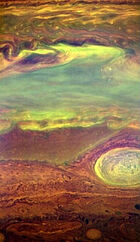
Jupiter through infrared camera.
The flyby came within about 32 Jovian radii (3 Gm) of Jupiter and was the center of a 4-month intensive observation campaign. Jupiter is an interesting, ever-changing target, observed intermittently since the end of the Galileo mission. New Horizons also has instruments built using the latest technology, especially in the area of cameras. They are much improved over Galileo's cameras, which were evolved versions of Voyager cameras which, in turn, were evolved Mariner cameras. The Jupiter encounter also served as a shakedown and dress rehearsal for the Pluto encounter. Because of the much shorter distance from Jupiter to Earth, the communications link can transmit multiple loadings of the memory buffer; thus the mission actually returned more data from the Jovian system than it is expected to transmit from Pluto. Imaging of Jupiter began on September 4, 2006, after which several images were taken.[43]
The primary encounter goals included Jovian cloud dynamics, which were greatly reduced from the Galileo observation program, and particle readings from the magnetotail of the Jovian magnetosphere. The spacecraft trajectory coincidentally flew down the magnetotail for months. New Horizons also examined the Jovian nightside for auroras and lightning.
New Horizons also provided the first close-up examination of Oval BA, a storm feature that has informally become known as the "Little Red Spot", since the storm turned red. It was still a white spot when Cassini flew by.
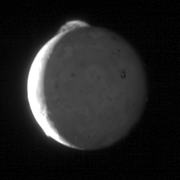
Animation of volcanic plumes on Io, a moon of Jupiter, by New Horizons.
Jovian moons[]
The major (Galilean) moons were in poor position. The aim point of the gravity-assist maneuver meant the spacecraft passed millions of kilometers from any of the Galilean moons. Still, the New Horizons instruments were intended for small, dim targets, so they were scientifically useful on large, distant moons. LORRI searched for volcanoes and plumes on Io. The infrared capabilities of LEISA searched for chemical compositions (including Europa ice dopants), and nightside temperatures (including hotspots on Io). The ultraviolet resolution of Alice searched for aurorae and atmospheres, including the Io torus.
Minor moons such as Amaltheahadtheir orbit solutions refined. The cameras determined their position, acting as "reverse optical navigation". Template:-
Pluto approach[]
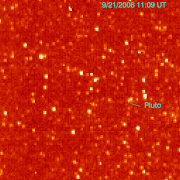
First Pluto sighting from New Horizons (September 21–24, 2006)
The first images of Pluto from New Horizons were created between September 21–24, 2006, during a test of the LORRI. They were released on November 28.[44] The images, taken from a distance of approximately 4.2 billion kilometers (2.6 billion miles), confirmed the spacecraft's ability to track distant targets, critical for maneuvering toward Pluto and other Kuiper belt objects.
It is planned for New Horizons to fly within of 10,000 km (6,200 mi Pluto in 2015. New Horizons will have a relative velocity of 13.78 km/s at closest approach, and will come as close as 27,000 km (17,000 mi) to Charon, although these parameters may be changed during flight.
Kuiper-belt mission[]
After passing by Pluto, New Horizons will continue farther into the Kuiper belt. Mission planners are now searching for one or more additional Kuiper belt objects (KBOs) on the order of 50–100 km (31–62 mi) in diameter for flybys similar to the spacecraft's Plutonian encounter. As maneuvering capability is limited, this phase of the mission is contingent on finding suitable KBOs close to New Horizons's flight path, ruling out any possibility for a planned flyby of Eris, a trans-Neptunian object comparable in size to Pluto.[45] The available region, being fairly close to the plane of the Milky Way and thus difficult to survey for dim objects, is one that has not been well-covered by previous KBO search efforts. The public helped to scan telescopic images for possible mission candidates by participating in the Ice Hunters project, although that project is now finished.[46][47]
Key mission dates[]
Template:Refimprove section
| Next event | Date | Event | Description | References |
|---|---|---|---|---|
| June 8, 2001 | New Horizons selected by NASA. | After a three month concept study before submission of the proposal, two design teams were competing: POSSE (Pluto and Outer Solar System Explorer) and New Horizons. | [48] | |
| June 13, 2005 | Spacecraft departed Applied Physics Laboratory for final testing. | Spacecraft undergoes final testing at Goddard Space Flight Center (GSFC). | [citation needed] | |
| September 24, 2005 | Spacecraft shipped to Cape Canaveral | It was moved through Andrews Air Force Base aboard a C-17 Globemaster III cargo aircraft. | [49] | |
| December 17, 2005 | Spacecraft ready for in rocket positioning | Transported from Hazardous Servicing Facility to Vertical Integration Facility at Space Launch Complex 41. | [citation needed] | |
| January 11, 2006 | Primary launch window opened | The launch was delayed for further testing. | [citation needed] | |
| January 16, 2006 | Rocket moved onto launch pad | Atlas V launcher, serial number AV-010, rolled out onto pad. | [citation needed] | |
| January 17, 2006 | Launch delayed | First day launch attempts scrubbed because of unacceptable weather conditions (high winds). | [citation needed] | |
| January 18, 2006 | Launch delayed again | Second launch attempt scrubbed because of morning power outage at the Applied Physics Laboratory. | [citation needed] | |
| January 19, 2006 | Successful launch at 14:00 EST (19:00 UTC) | The spacecraft was successfully launched after brief delay due to cloud cover. | [50][51] | |
| April 7, 2006 | Passing of Mars's orbit | The probe passed Mars's orbit: 1.7 AU from Earth. | [52][53] | |
| June 13, 2006 | Flyby of asteroid 132524 APL | The probe passed closest to the asteroid 132524 APL in the Belt at about 101,867 km at 04:05 UTC. Pictures were taken. | [54] | |
| November 28, 2006 | First image of Pluto | The image of Pluto was taken from a great distance, rendering the dwarf planet faint. | [44] | |
| January 10, 2007 | Navigation exercise near Jupiter | Long distance observations of Jupiter's outer moon Callirrhoe as a navigation exercise. | [55] | |
| February 28, 2007 | Jupiter flyby | Closest approach occurred at 05:43:40 UTC at 2.305 million km, 21.219 km/s. | [56] | |
| June 8, 2008 | Passing of Saturn's orbit | The probe passed Saturn's orbit: 9.5 AU from Earth. | [56][57] | |
| December 29, 2009 | The probe became closer to Pluto than to Earth | Pluto was then 32.7 AU from Earth, and the probe was 16.4 AU from Earth | [58][59][60] | |
| February 25, 2010 | Half mission distance reached | Half the travel distance of 69 was completed. | [61] | |
| March 18, 2011 | The probe passed Uranus's orbit | This is the fourth planetary orbit the spacecraft crossed since its start. New Horizons reached Uranus's orbit at 22:00 GMT. | [62][63] | |
| December 2, 2011 | New Horizons drew closer to Pluto than any other spacecraft has ever been. | Previously, Voyager 1 held the record for the closest approach. (~10.58 AU) | [64] | |
| February 11, 2012 | New Horizons was 10 AU from Pluto. | Happened at around 4:55 UTC. | [19] | |
| File:Fairytale right.png | October 2013 | New Horizons will be 5 AU from Pluto. | [19] | |
| August 24, 2014 | The probe will pass Neptune's orbit | This will be the fifth planetary orbit the spacecraft crosses. | [65] | |
| February 2015 | Observations of Pluto begin | New Horizons is now close enough to Pluto for the main science mission to begin. | [56] | |
| May 5, 2015 | Better than Hubble | Images exceed best Hubble Space Telescope resolution. | [56] | |
| July 14, 2015 | Flyby of Pluto, Charon, Hydra, Nix, S/2011 P 1 and S/2012 P 1 | Flyby of Pluto around 11:47 UTC at 13,695 km, 13.78 km/s. Flyby of Charon, Hydra, Nix, S/2011 P 1 and S/2012 P 1 around 12:01 UTC at 29,473 km, 13.87 km/s. | [56] | |
| 2016–2020 | Possible flyby of one or more Kuiper belt objects (KBOs) | The probe will perform flybys of other KBOs, if any are in the spacecraft's proximity. | [66] | |
| 2026 | Expected end of mission | According to NASA,[67] the Dwarf Planets mission will come to an end. |
Spacecraft subsystems[]
The spacecraft is comparable in size and general shape to a grand piano and has been compared to a piano glued to a cocktail bar-sized satellite dish.[68] As a point of departure, the team took inspiration from the Ulysses spacecraft,[69] which also carried a radioisotope thermoelectric generator (RTG) and dish on a box-in-box structure through the outer Solar System. Many subsystems and components have flight heritage from APL's CONTOUR spacecraft, which in turn had heritage from APL's TIMED spacecraft.
Structural[]
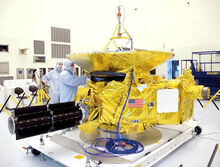
New Horizons in its assembly hall. The black tube to the left is the RTG.
The spacecraft's body forms a triangle, almost 2.5 feet (0.76 m) thick. (The Pioneers had hexagonal bodies, while the Voyagers, Galileo, and Cassini–Huygenshad decagonal, hollow bodies.) A 7075 aluminium alloy tube forms the main structural column, between the launch vehicle adapter ring at the "rear," and the 2.1 m radio dish antenna affixed to the "front" flat side. The titanium fuel tank is in this tube. The RTG attaches with a 4-sided titanium mount resembling a grey pyramid or stepstool. Titanium provides strength and thermal isolation. The rest of the triangle is primarily sandwich panels of thin aluminium facesheet (less than 1⁄64 in or 0.40 mm) bonded to aluminium honeycomb core. The structure is larger than strictly necessary, with empty space inside. The structure is designed to act as shielding, reducing electronics errors caused by radiation from the RTG. Also, the mass distribution required for a spinning spacecraft demands a wider triangle
Propulsion and attitude control[]
New Horizons has both spin-stabilized (cruise) and three-axis stabilized (science) modes, controlled entirely with hydrazine monopropellant. 77 kg (170 lb) of hydrazine provides a delta-v capability of over 290 m/s (649 mph) after launch. Helium is used as a pressurant, with an elastomeric diaphragm assisting expulsion. The spacecraft's on-orbit mass including fuel will be over 470 kg (1,036 lb) for a Jupiter flyby trajectory, but would have been only 445 kg (981 lb) for a direct flight to Pluto. This would have meant less fuel for later Kuiper belt operations and is caused by the launch vehicle performance limitations for a direct-to-Pluto flight.
There are 16 thrusters on New Horizons: four 4.4 N (1.0 lbf) and twelve 0.9 N (0.2 lbf) plumbed into redundant branches. The larger thrusters are used primarily for trajectory corrections, and the small ones (previously used on Cassini and the Voyager spacecraft) are used primarily for attitude control and spinup/spindown maneuvers. Two star cameras (from Galileo Avionica) are used for fine attitude control. They are mounted on the face of the spacecraft and provide attitude information while in spinning or in 3-axis mode. Between star camera readings, knowledge is provided by dual redundant Miniature Inertial Measurement Unit (MIMU) from Honeywell. Each unit contains three solid-state gyroscopes and three accelerometers. Two Adcole Sun sensors provide coarse attitude control. One detects angle to the Sun, while the other measures spin rate and clocking.
Power[]
A cylindrical radioisotope thermoelectric generator (RTG), protrudes from one vertex in the plane of the triangle. The RTG will provide about 240 W, 30 V DC at launch, and is predicted to drop approximately 5% every 4 years, decaying to 200 W by the encounter with the Plutonian system in 2015. The RTG, model "GPHS-RTG," was originally a spare from the Cassini mission. The RTG contains 11 kg (24 lb) of plutonium-238 oxide pellets. Each pellet is clad in iridium, then encased in a graphite shell. It was developed by the U.S Department of Energy.
The use of a plutonium RTG battery was opposed by about 30 anti-nuclear protesters in minor demonstrations some days before launch. The amount of radioactive plutonium in the RTG is 10.9 kg, about one-third the amount on board the Cassini–Huygens probe when it launched in 1997. That launch was protested by over 300 people.[citation needed] The United States Department of Energy estimated the chances of a launch accident that would release radiation into the atmosphere at 1 in 350 and monitored the launch[70] as it always does when RTGs are involved. It was believed that a worst-case scenario of total dispersal of on-board plutonium would spread the equivalent radiation of 80% the average annual dosage in North America from background radiation over an area with a radius of 105 km (65 mi),[citation needed] at the Materials and Fuels Complex (formerly Argonne West), a part of the Idaho National Laboratory in Bingham County, near the town of Arco and the city of Idaho Falls.[71] The plutonium was produced at Los Alamos National Laboratory in New Mexico.[citation needed] Less than the original design goal was produced, due to delays at the United States Department of Energy, including security activities, which held up production. The mission parameters and observation sequence had to be modified for the reduced wattage; still, not all instruments can operate simultaneously. The Department of Energy transferred the space battery program from Ohio to Argonne in 2002 because of security concerns. There are no onboard batteries. RTG output is relatively predictable; load transients are handled by a capacitor bank and fast circuit breakers.
Thermal[]
Internally, the structure is painted black. This equalizes temperature by radiative heat transfer. Overall, the spacecraft is thoroughly blanketed to retain heat. Unlike the Pioneers and Voyagers, the radio dish is also enclosed in blankets which extend to the body. The heat from the RTG also adds warmth to the spacecraft in the outer Solar System. In the inner Solar System, the spacecraft must prevent overheating. Electronic activity is limited, power is diverted to shunts with attached radiators, and louvers are opened to radiate excess heat. Then, when the spacecraft is cruising inactively in the cold outer Solar System, the louvers are closed, and the shunt regulator reroutes power to electric heaters.
Telecommunications[]
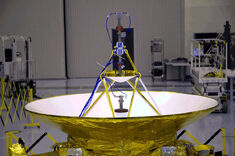
Antennas of New Horizons (HGA, MGA and LGA).
Communication with the spacecraft is via X band.
At Pluto's distance, a rate of approximately 1,000 bits per second is expected. The craft had a communication rate of 38 kbit/s at Jupiter.
The 70 m Deep Space Network (DSN) dishes will be used to relay data beyond Jupiter.
Besides the low bandwidth, Pluto's distance also causes a (one way) latency of about 4.5 hours.
The spacecraft uses dual redundant transmitters and receivers, and either right- or left-hand circular polarization. The downlink signal is amplified by dual redundant 12-watt TWTAs (traveling-wave tube amplifiers) mounted on the body under the dish.
The receivers are new, low-power designs. The system can be controlled to power both TWTAs at the same time, and transmit a dual-polarized downlink signal to the DSN that could almost double the downlink rate. Initial tests with the DSN in this dual-polarized mode have been successful, and an effort to make the DSN polarization-combining technique operational is underway.
In addition to the high-gain antenna, there are two low-gain antennas and a medium-gain dish. The high-gain dish has a Cassegrain layout, composite construction, and a 2.1 meter diameter (providing well over 40 dB of gain, and a half-power beam width of about a degree). The prime-focus, medium-gain antenna, with a 0.3 meter aperture and 10-degree half-power beamwidth, is mounted to the back of the high-gain antenna's secondary reflector. The forward low-gain antenna is stacked atop the feed of the medium-gain antenna. The aft low-gain antenna is mounted within the launch adapter at the rear of the spacecraft. This antenna was only used for early mission phases near Earth, just after launch and for emergencies if the spacecraft had lost attitude control.
To save mission costs, the spacecraft will be in "hibernation" between Jupiter and Pluto. It will awaken once per year, for 50 days, for equipment checkout and trajectory tracking. The rest of the time, the spacecraft will be in a slow spin, sending a beacon tone which will be checked once per week. Depending on frequency, the beacon indicates normal operation, or one of seven fault modes. New Horizons is the first mission to use the DSN's beacon tone system operationally, the system having been flight-tested by the DS1 mission.
Data handling[]
New Horizons will record scientific instrument data to its solid-state buffer at each encounter, then transmit the data to Earth. Data storage is done on two low-power solid-state recorders (one primary, one backup) holding up to 8 gigabytes each. Because of the extreme distance from Pluto and the Kuiper belt, only one buffer load at those encounters can be saved. This is because New Horizons will have left the vicinity of Pluto (or future target object) by the time it takes to transmit the buffer load back to Earth.
Part of the reason for the delay between the gathering and transmission of data is because all of the New Horizons instrumentation is body-mounted. In order for the cameras to record data, the entire probe must turn, and the one-degree-wide beam of the high-gain antenna will almost certainly not be pointing toward Earth. Previous spacecraft, such as the Voyager program probes, had a rotatable instrumentation platform (a "scan platform") that could take measurements from virtually any angle without losing radio contact with Earth. New Horizons' elimination of excess mechanisms was implemented to save weight, shorten the schedule, and improve reliability to achieve a 15+-year lifetime.
(The Voyager 2 spacecraft experienced platform jamming at Saturn; the demands of long time exposures at Uranus led to modifications of the mission such that the entire probe was rotated to achieve the time exposure photos at Uranus and Neptune, similar to how New Horizons will rotate.)
Flight computer[]
The spacecraft carries two computer systems, the Command and Data Handling system and the Guidance and Control processor. Each of the two systems is duplicated for redundancy, giving a total of four computers. The processor used is the Mongoose-V, a 12 MHz radiation-hardened version of the MIPS R3000 CPU. Multiple clocks and timing routines are implemented in hardware and software to help prevent faults and downtime.
To conserve heat and mass, spacecraft and instrument electronics are housed together in IEMs (Integrated Electronics Modules). There are two redundant IEMs. Including other functions such as instrument and radio electronics, each IEM contains 9 boards.
On March 19, 2007 the Command and Data Handling computer experienced an uncorrectable memory error and rebooted itself, causing the spacecraft to go into safe mode. The craft fully recovered within two days, with some data loss on Jupiter's magnetotail. No impact on the subsequent mission is expected.[72]
Mission science[]
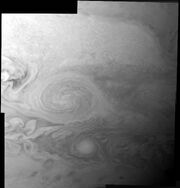
Enhanced view of Jupiter's "Little Red Spot" by the New Horizons space probe.
The spacecraft carries seven scientific instruments. Total mass is 31 kg; rated power is 21 watts (though not all instruments operate simultaneously).[73]
- Fundamental physics-Pioneer Anomaly
- It was shown that New Horizons may be used to test the Pioneer Anomaly issue.[74]
- Long Range Reconnaissance Imager (LORRI)
- LORRI is a long focal length imager designed for high resolution and responsivity at visible wavelengths. The instrument is equipped with a high-resolution 1024×1024 monochromatic CCD imager with a 69 aperture giving a resolution of 5 microradians (approximately one arcsecond). The CCD is chilled far below freezing by a passive radiator on the antisolar face of the spacecraft. This temperature differential requires insulation, and isolation from the rest of the structure. The Ritchey-Chretien mirrors and metering structure are made of silicon carbide, to boost stiffness, reduce weight, and prevent warping at low temperatures. The optical elements sit in a composite light shield, and mount with titanium and fibreglass for thermal isolation. Overall mass is 8.6 kg, with the Optical tube assembly (OTA) weighing about 5.6 kg,[75] for one of the largest silicon-carbide telescopes yet flown.
- Pluto Exploration Remote Sensing Investigation (PERSI)
- This consists of two instruments: The Ralph telescope, 6 centimeters in aperture, with two separate channels: a visible-light CCD imager (MVIC- Multispectral Visible Imaging Camera) with broadband and color channels, and a near-infrared imaging spectrometer, LEISA (Linear Etalon Imaging Spectral Array). LEISA is derived from a similar instrument on the EO-1 mission. The second instrument is an ultraviolet imaging spectrometer, Alice. Alice resolves 1,024 wavelength bands in the far and extreme ultraviolet (from 180 to 50 nanometers), over 32 view fields. Its goal is to view the atmospheric makeup of Pluto. This Alice is derived from an Alice on the Rosetta mission. Ralph, designed afterwards, was named after Alice's husband on The Honeymooners. Ralph and Alice are names, not acronyms.
- Plasma and high energy particle spectrometer suite (PAM)
- PAM consists of two instruments viz., SWAP (Solar Wind At Pluto), a toroidal electrostatic analyzer and retarding potential analyzer, and PEPSSI (Pluto Energetic Particle Spectrometer Science Investigation), a time of flight ion and electron sensor. SWAP measures particles of up to 6.5 keV, PEPSSI goes up to 1 MeV. Because of the tenuous solar wind at Pluto's distance, the SWAP instrument has the largest aperture of any such instrument ever flown.
- Radio Science Experiment (REX)
- REX will use an ultrastable crystal oscillator (essentially a calibrated crystal in a miniature oven) and some additional electronics to conduct radio science investigations using the communications channels. These are small enough to fit on a single card. Since there are two redundant communications subsystems, there are two, identical REX circuit boards.

New Horizon's image of Jupiter's Himalia
- Venetia Burney Student Dust Counter (VBSDC)
- Built by students at the University of Colorado at Boulder, the Student Dust Counter will operate continuously through the trajectory to make dust measurements. It consists of a detector panel, about 69, mounted on the antisolar face of the spacecraft (the ram direction), and an electronics box within the spacecraft. The detector contains fourteen PVDF panels, twelve science and two reference, which generate voltage when impacted. Effective collecting area is 0.125 m². No dust counter has operated past the orbit of Uranus; models of dust in the outer Solar System, especially the Kuiper belt, are speculative. VBSDC is always turned on measuring the masses of the interplanetary and interstellar dust particles (in the range of nano and pico grams) as they collide with the PVDF panels mounted on the New Horizons spacecraft. The measured data shall greatly contribute to the understanding of the dust spectra of the Solar System. The dust spectra can then be compared with those observed via telescope of other stars, giving new clues as to where earthlike planets can be found in our universe. The dust counter is named for Venetia Burney, who first suggested the name "Pluto" at the age of 11. An interesting thirteen minute short film about VBSDC garnered an Emmy award for student achievement in 2006.[76]
Gallery[]
Pluto flyby[]
Template:Refimprove section
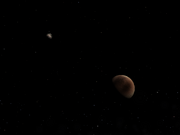
Computer-generated view from the spacecraft during flyby of Pluto (right) showing its moon, Charon (left).
Observations of Pluto, with LORRI plus Ralph, will begin about 6 months prior to closest approach. The targets will be only a few pixels across. 70 days out, resolution will exceed the Hubble Space Telescope's resolution,[56] lasting another two weeks after the flyby. This should detect any rings or any additional moons (eventually down to 2 kilometers diameter), for avoidance and targeting maneuvers, and observation scheduling. Long-range imaging will include 69 mapping of Pluto and Charon 3.2 days out. This is half the rotation period of Pluto–Charon and will allow imaging of the side of both bodies that will be facing away from the spacecraft at closest approach. Coverage will repeat twice per day, to search for changes due to snows or cryovolcanism. Still, due to Pluto's tilt and rotation, a portion of the northern hemisphere will be in shadow at all times.
During the flyby, LORRI should be able to obtain select images with resolution as high as 50 m/px (if closest distance is around 10,000 km), and MVIC should obtain 4-color global dayside maps at 1.6 km resolution. LORRI and MVIC will attempt to overlap their respective coverage areas to form stereo pairs. LEISA will obtain hyperspectral near-infrared maps at 7 km/px globally and 0.6 km/pixel for selected areas. Meanwhile, Alice will characterize the atmosphere, both by emissions of atmospheric molecules (airglow), and by dimming of background stars as they pass behind Pluto (occultation).
During and after closest approach, SWAP and PEPSSI will sample the high atmosphere and its effects on the solar wind. VBSDC will search for dust, inferring meteoroid collision rates and any invisible rings. REX will perform active and passive radio science. Ground stations on Earth will transmit a powerful radio signal as New Horizons passes behind Pluto's disk, then emerges on the other side. The communications dish will measure the disappearance and reappearance of the signal. The results will resolve Pluto's diameter (by their timing) and atmospheric density and composition (by their weakening and strengthening pattern). (Alice can perform similar occultations, using sunlight instead of radio beacons.) Previous missions had the spacecraft transmit through the atmosphere, to Earth ("downlink"). Low power and extreme distance means New Horizons will be the first such "uplink" mission. Pluto's mass and mass distribution will be evaluated by their tug on the spacecraft. As the spacecraft speeds up and slows down, the radio signal will experience a Doppler shift. The Doppler shift will be measured by comparison with the ultrastable oscillator in the communications electronics.
Reflected sunlight from Charon will allow some imaging observations of the nightside. Backlighting by the Sun will highlight any rings or atmospheric hazes. REX will perform radiometry of the nightside.
Initial, highly-compressed images will be transmitted within days. The science team will select the best images for public release. Uncompressed images will take about nine months[citation needed] to transmit, depending on Deep Space Network traffic. It may turn out, however, that fewer months will be needed. The spacecraft link is proving stronger than expected, and it is possible that both downlink channels may be ganged together to nearly double the data rate.
- Primary objectives (required)
- Characterize the global geology and morphology of Pluto and Charon
- Map chemical compositions of Pluto and Charon surfaces
- Characterize the neutral (non-ionized) atmosphere of Pluto and its escape rate
Loss of any of these objectives will constitute a failure of the mission.
- Secondary objectives (expected)
- Characterize the time variability of Pluto's surface and atmosphere
- Image select Pluto and Charon areas in stereo
- Map the terminators (day/night border) of Pluto and Charon with high resolution
- Map the chemical compositions of select Pluto and Charon areas with high resolution
- Characterize Pluto's ionosphere, and its interaction with the solar wind
- Search for neutral species such as H2, hydrocarbons, HCN and other nitriles in the atmosphere
- Search for any Charon atmosphere
- Determine bolometric Bond albedos for Pluto and Charon
- Map surface temperatures of Pluto and Charon
It is expected, but not demanded, that most of these objectives will be met.
- Tertiary objectives (desired)
- Characterize the energetic particle environment at Pluto and Charon
- Refine bulk parameters (radii, masses) and orbits of Pluto and Charon
- Search for additional moons, and any rings
These objectives may be attempted, though they may be skipped in favor of the above objectives. An objective to measure any magnetic field of Pluto was dropped. A magnetometer instrument could not be implemented within a reasonable mass budget and schedule, and SWAP and PEPSSI could do an indirect job detecting some magnetic field around Pluto.
Asteroid belt[]
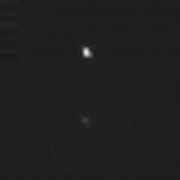
The 2.5 kilometer-wide asteroid 132524 APL, photographed by the New Horizons probe
Because of the need to conserve fuel for possible encounters with Kuiper belt objects subsequent to the Pluto flyby, intentional encounters with objects in the asteroid belt were not planned. Subsequent to launch, the New Horizons team scanned the spacecraft's trajectory to determine if any asteroids would, by chance, be close enough for observation. In May 2006 it was discovered that New Horizons would pass close to the tiny asteroid 132524 APL on June 13, 2006. Closest approach occurred at 4:05 UTC at a distance of 69. The asteroid was imaged by Ralph (use of LORRI at that time was not possible due to proximity to Sun), which gave the team a chance to exercise Ralph's capabilities, and make observations of the asteroid's composition as well as light and phase curves. The asteroid was estimated to be 69 in diameter.[77][78][79]
Neptune trojans[]
Other possible targets are Neptune trojans. The probe's trajectory to Pluto passes near Neptune's trailing Lagrange point ("Template:L5"), which may host hundreds of bodies in 1:1 resonance with the planet. In late 2013, New Horizons will pass within 1.2 AU (180 million km) of the recently discovered large, high-inclination L5 Neptune trojan 2011 HM102,[80] which was identified by the New Horizons KBO Search Survey team while searching for more distant objects for New Horizons to fly by after its 2015 Pluto encounter. At this range, 2011 HM102 may be bright enough to be detectable by New Horizons' LORRI instrument. However, the 2011 HM102 flyby comes shortly before the Pluto encounter. At that time, New Horizons may not have significant downlink bandwidth, and thus free memory, for trojan encounter data.[81]
Kuiper belt objects[]
New Horizons is designed to fly past one or more Kuiper belt objects (KBOs) after passing Pluto. Because the flight path is determined by the Pluto flyby, with only minimal hydrazine remaining, objects must be found within a cone, extending from Pluto, of less than a degree's width, within 55 AU. Past 55 AU, the communications link becomes too weak, and the RTG wattage will have decayed significantly enough to hinder observations. Desirable KBOs will be well over 50 km in diameter, neutral in color (to compare with the reddish Pluto), and, if possible, possess a moon. Because the population of KBOs appears quite large, multiple objects may qualify. Large ground telescopes with wide-field cameras, notably the twin Magellan Telescopes, the Subaru Observatory and the Canada-France-Hawaii Telescope[80] are being used to search for potential targets up until the Pluto flyby; the Pluto aim point, plus subsequent thruster firing, will then determine the post-Pluto trajectory. The citizen science project Ice Hunters has aided in the search for a suitable object.[82][83][84] With the completion of the Ice Hunters project, 143 KBO's of potential interest have been found.[85]
An extension of the project, Ice Investigators, is being launched.[86] KBO flyby observations will be similar to those at Pluto, but reduced due to lower light, power, and bandwidth. On August 21, 2012 the New Horizons team announced on their Twitter feed that they will attempt distant observations of the object VNH0004 just before the Pluto encounter[87] in January 2015 at a distance of 75 million kilometers.[88]
Heliosphere[]
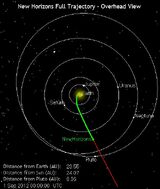
Simulated view of the position of New Horizons as of September 1, 2012 showing spacecraft trajectory since launch.
Provided it survives that far out, New Horizons is likely to follow the Voyager probes in exploring the outer heliosphere and mapping the heliosheath and heliopause.
Even though it was launched far faster than any outward probe before it, New Horizons will never overtake Voyager 1 as the most distant man-made object from Earth. Close fly-bys of Saturn and Titan gave Voyager 1 an advantage with its extra gravity assist. When New Horizons reaches the distance of 100 AU, it will be travelling at about 69, around 69 slower than Voyager 1 at that distance.[89]
Current status[]
- See also: New Horizons#Key mission dates
On September 9, 2012, New Horizons was 69 from the Earth and 69 from the Sun; and traveling at 69 (relative to the Sun) and traveling outward at about 3.224 AU per year.[90] Sunlight takes 3.31 hours to get to New Horizons. The brightness of the Sun from the spacecraft is magnitude -19.7.[90] New Horizons is heading in the direction of the constellation Sagittarius.[90]
See also[]
- List of spaceflights (2006)
- Pioneer 10
- Pioneer 11
- Timeline of Solar System exploration
- Space exploration
- Unmanned space missions
- Voyager 1
- Voyager 2
References[]
- ↑ HORIZONS Web-Interface. NASA/JPL. Retrieved on July 25, 2016. To find results, change Target Body to "New Horizons" and change Time Span to include "2017-01-01".
- ↑ Chang, Kenneth, "The Long, Strange Trip to Pluto, and How NASA Nearly Missed It", New York Times, July 18, 2015. Retrieved on July 19, 2015.
- ↑ Template:Cite podcast
- ↑ New Horizons to Pluto, Mission Website. US National Aeronautics and Space Administration (NASA) (July 2, 2015). Retrieved on July 7, 2015.
- ↑ Chang, Kenneth, "A Close-Up for Pluto After Spacecraft's 3-Billion-MileTrip", New York Times, July 13, 2015. Retrieved on July 13, 2015.
- ↑ Chang, Kenneth, "Almost Time for Pluto's Close-Up", New York Times, July 6, 2015. Retrieved on July 6, 2015.
- ↑ 7.0 7.1 Overbye, Dennis, "Reaching Pluto, and the End of an Era of Planetary Exploration", New York Times, July 6, 2015. Retrieved on July 7, 2015.
- ↑ Roston, Michael, "NASA's Next Horizon in Space", New York Times, August 28, 2015. Retrieved on August 28, 2015.
- ↑ New Horizons: NASA's Mission to Pluto. NASA. Retrieved on April 15, 2015.
- ↑ New Horizons - News. Johns Hopkins Applied Physics Laboratory (December 6, 2014). Retrieved on April 15, 2015.
- ↑ Chang, Kenneth, "NASA's New Horizons Spacecraft Completes Flyby of Pluto", The New York Times, July 14, 2015. Retrieved on July 14, 2015.
- ↑ Dunn, Marcia, "Pluto close-up: Spacecraft makes flyby of icy, mystery world", Excite, July 14, 2015. Retrieved on July 14, 2015.
- ↑ 15-149 NASA's Three-Billion-Mile Journey to Pluto Reaches Historic Encounter. NASA (July 14, 2015). Retrieved on July 14, 2015.
- ↑ Chang, Kenneth, "No More Data From Pluto", The New York Times, October 28, 2016. Retrieved on October 28, 2016.
- ↑ Jayawardhana, Ray, "Give It Up for Pluto", New York Times, December 11, 2015. Retrieved on December 11, 2015.
- ↑ 16.0 16.1 Talbert, Tricia (August 28, 2015). NASA's New Horizons Team Selects Potential Kuiper Belt Flyby Target. NASA. Retrieved on September 4, 2015.
- ↑ 17.0 17.1 Beyond Pluto: 2nd Target Chosen for New Horizons Probe. Space.com (August 28, 2015). Retrieved on August 30, 2015.
- ↑ Dunn, Marcia, "NASA's New Horizons on new post-Pluto mission", AP News, October 22, 2015. Retrieved on October 25, 2015.
- ↑ 19.0 19.1 19.2 New Horizons on Approach: 22 AU Down, Just 10 to Go. JHU/APL (February 10, 2012). Retrieved on March 22, 2012.
- ↑ The New Horizons Pluto Kuiper belt Mission: An Overview with Historical Context. Springerlink. Retrieved on June 30, 2009.
- ↑ The New Horizons Mission to the Pluto System and the Kuiper Belt. IEEE. Retrieved on June 30, 2009.
- ↑ Departments of Space Studies & Space Operations. Southwest Research Institute Planetary Science Directorate website. Southwest Research Institute. Retrieved on March 14, 2010.
- ↑ Unabashedly Onward to the Ninth Planet. New Horizons website. Johns Hopkins APL. Archived from the original on March 9, 2011. Retrieved on October 25, 2008.
- ↑ Template:Cite press release Template:WebCite
- ↑ Send Your Name to Pluto. New Horizons website. Johns Hopkins APL. Archived from the original on March 9, 2011. Retrieved on January 30, 2009.
- ↑ "Pluto Mission to Carry Piece of SpaceShipOne", Space.com, December 20, 2005.
- ↑ "To Pluto, With Postage", collectSPACE, October 28, 2008.
- ↑ "New Horizons launches on voyage to Pluto and beyond", spaceFlightNow, January 19, 2006. Retrieved on December 1, 2010.
- ↑ [1] a coin to pay the boatman for Tombaugh]
- ↑ "Damage prompts booster replacement for Pluto probe", spaceFlightNow. Retrieved on July 31, 2007.
- ↑ Tariq Malik. "Derelict Booster to Beat Pluto Probe to Jupiter", Space.com. Retrieved on September 22, 2006.
- ↑ Stern, Alan (January 31 2006). Our Aim Is True. The PI's Perspective. Johns Hopkins APL. Archived from the original on March 9, 2011. Retrieved on June 11, 2006.
- ↑ Stern, Alan (February 27 2006). Boulder and Baltimore. The PI's Perspective. Johns Hopkins APL. Archived from the original on March 9, 2011. Retrieved on June 11, 2006.
- ↑ New Horizons Adjusts Course Towards Jupiter. JHU/APL (March 9, 2006). Retrieved on May 29, 2011.Template:WebCite
- ↑ Buckley, M. (September 27, 2007). Maneuver Puts New Horizons on a Straight Path to Pluto. Retrieved on March 1, 2011.Template:WebCite
- ↑ Course Correction Keeps New Horizons on Path to Pluto. JHU/APL (July 1, 2010). Retrieved on January 41, 2011.Template:WebCite
- ↑ "Outbound for the Frontier, New Horizons Crosses the Orbit of Mars", Johns Hopkins APL, April 7, 2006. Template:Dead link
- ↑ "New Horizons Tracks an Asteroid", Johns Hopkins APL, June 15, 2006.
- ↑ Jupiter Ahoy!. Pluto.jhuapl.edu. Retrieved on October 27, 2008.Template:WebCite
- ↑ Peat, Chris. Spacecraft escaping the Solar System. Heavens Above GmbH. Retrieved on May 29, 2011.Template:WebCite
- ↑ Alexander, Amir (September 27, 2006). New Horizons Snaps First Picture of Jupiter. The Planetary Society. Archived from the original on March 9, 2011. Retrieved on December 19, 2006.
- ↑ Fantastic Flyby – NASA Science. NASA (May 1, 2007). Retrieved on May 29, 2011.Template:WebCite
- ↑ Malik, Tariq (February 28, 2007). Pluto probe gets an eyeful in Jupiter flyby. msnbc.com. Retrieved on May 29, 2011.Template:WebCite
- ↑ 44.0 44.1 K. Beisser (November 28, 2006). New Horizons, Not Quite to Jupiter, Makes First Pluto Sighting. JHU/APL. Archived from the original on March 9, 2011. Retrieved on January 13, 2011.
- ↑ Atkinson, Nancy (November 11, 2010). Stellar Occultation by Eris. Universe Today. Retrieved on May 29, 2011.Template:WebCite
- ↑ IceHunters. Zooniverse (2011). Retrieved on June 27, 2011.
- ↑ IceHunters project complete. Zooniverse (2012). Retrieved on August 7, 2012.
- ↑ Savage, D. (November 29, 2001). NASA Selects Pluto-Kuiper Belt Mission For Phase B Study. NASA. Retrieved on January 12, 2011.archived at WebCite
- ↑ NASA'S Pluto Space Probe Begins Launch Preparations. SpaceDaily (September 27, 2005). Archived from the original on March 9, 2011. Retrieved on January 12, 2011.
- ↑ Amir, A. (January 19, 2006). Planetary News: New Horizons (2006) New Horizons launched on its way to Pluto. The Planetary Society. Archived from the original on April 21, 2006. Retrieved on March 14, 2011. archived at WebCite
- ↑ Harwood, W. (January 19, 2006). New Horizons launches on voyage to Pluto and beyond. Spaceflight Now Inc.. Retrieved on January 12, 2011.archived at WebCite
- ↑ Malik, T. (April 7, 2006). Pluto-Bound Probe Passes Mars' Orbit. Space.com. Archived from the original on March 9, 2011. Retrieved on January 14, 2011.
- ↑ Distance between Mars and Earth on 7 April 2006.
- ↑ Olkin, Catherine B., et al. (2006). "The New Horizons Distant Flyby of Asteroid 2002 JF56". Bulletin of the American Astronomical Society 38.
- ↑ New Horizons Jupiter Flyby Timeline. The Planetary Society. Archived from the original on March 6, 2007. Retrieved on March 22, 2012.
- ↑ 56.0 56.1 56.2 56.3 56.4 56.5 New Horizons Web Site. Pluto.jhuapl.edu. Retrieved on August 1, 2012.
- ↑ Distance between Saturn and Earth on 8 June 2008. Retrieved on March 2011.
- ↑ Villard, R. (December 29, 2009). New Horizons Crosses Halfway Point to Pluto. Discovery Communications, LLC.. Archived from the original on March 9, 2011. Retrieved on January 12, 2011.
- ↑ Distance between Pluto and Earth on 29 December 2009. Retrieved on March 2011.
- ↑ New Horizon properties on 29 December 2009. Retrieved on March 2011.
- ↑ Spacecraft Hits Midpoint on Flight to Pluto. Space.com (February 26, 2010). Retrieved on August 11, 2011.
- ↑ Space Spin – New Horizons ventures beyond Saturn's orbit (June 9, 2008). Retrieved on March 14, 2011.
- ↑ SPACE.com Staff (March 18, 2011). NASA Pluto Probe Passes Orbit of Uranus. SPACE.com. Retrieved on March 19, 2011.
- ↑ Twitter.com – NewHorizons2015
- ↑ New Horizons Web Site. Pluto.jhuapl.edu (March 18, 2011). Retrieved on April 3, 2012.
- ↑ Why Go to Pluto?. NASA. Retrieved on July 14, 2011.
- ↑ NASA (July 20, 2011). New Horizons. NASA Solar System Exploration. National Aeronautics and Space Administration. Retrieved on February 21, 2012.
- ↑ Cite error: Invalid
<ref>tag; no text was provided for refs namedMoore-2010 - ↑ Template:Cite doi
- ↑ Pluto Probe Launch Scrubbed for Tuesday January 18, 2006 Template:WebCite
- ↑ Friederich, Steven, "Argonne Lab is developing battery for NASA missions", Idaho State Journal, December 16, 2003.Template:Dead link
- ↑ The PI's Perspective: Trip Report. NASA/Johns Hopkins University/APL/New Horizons Mission (March 27, 2007). Archived from the original on March 9, 2011. Retrieved on August 5, 2009.
- ↑ Y. Guo, R. W. Farquhar (2006). "Baseline design of New Horizons mission to Pluto and the Kuiper belt". Acta Astronautica 58 (10): 550–559. DOI:10.1016/j.actaastro.January+1,+20062.
- ↑ M.M. Nieto (2008). "New Horizons and the onset of the Pioneer anomaly". Physics Letters B 659 (3): 483–485. DOI:10.1016/j.physletb.2007.11.067.
- ↑ A. F. Cheng et al.. Long-Range Reconnaissance Imager on New Horizons.
- ↑ YouTube – Destination: Pluto and Beyond Template:WebCite
- ↑ Stern, Alan (June 1 2006). A Summer's Crossing of the Asteroid Belt. The PI's Perspective. Johns Hopkins APL. Archived from the original on March 9, 2011. Retrieved on June 20, 2010.
- ↑ JF56 Encounter, Encounter Date June 13, 2006 UT. Pluto New Horizons Mission, Supporting Observations for 2002. International Astronomical Union. Archived from the original on August 5, 2007. Retrieved on June 20, 2010.
- ↑ New Horizons Tracks an Asteroid. Headlines: New Horizons Web site. Johns Hopkins APL. Archived from the original on March 9, 2011. Retrieved on June 20, 2010.
- ↑ 80.0 80.1 Parker, Alex H., and 21 co-authors. (October 2012). "2011 HM102: Discovery of a High-Inclination L5 Neptune Trojan in the Search for a post-Pluto New Horizons Target". eprint arXiv:1210.4549. Retrieved on 2012-10-31.
- ↑ Stern, Alan (May 1 2006). Where Is the Centaur Rocket?. The PI's Perspective. Johns Hopkins APL. Archived from the original on March 9, 2011. Retrieved on June 11, 2006.
- ↑ Ice Hunters web site. Zooniverse.Org. Retrieved on July 8, 2011.
- ↑ Citizen Scientists: Discover a New Horizons Flyby Target. NASA (Jun 21, 2011). Retrieved on August 23, 2011.
- ↑ Lakdawalla, Emily (June 21, 2011). The most exciting citizen science project ever (to me, anyway). The Planetary Society. Retrieved on August 31, 2011.
- ↑ Confirmed KBOs. Zooniverse. Retrieved on August 21, 2012.
- ↑ Ice Investigators. web site. CosmoQuest (2012). Retrieved on May 23, 2012.
- ↑ NewHorizons2015. About the Jan 21o5 KBO, It's VNH0004. Twitter. Retrieved on August 21, 2012.
• Buie, Marc W.. Orbit Fit and Astrometric record for VNH0004. User pages. Southwest Research Institute Planetary Science Directorate. Retrieved on August 21, 2012. - ↑ NewHorizons2015. Our possible KBO encounter in Jan 2015 ... 75 million km. Twitter. Retrieved on August 21, 2012.
- ↑ New Horizons Salutes Voyager. New Horizons (August 17, 2006). Archived from the original on March 9, 2011. Retrieved on November 3, 2009.
- ↑ 90.0 90.1 90.2 Peat, Chris (September 9, 2012). Spacecraft escaping the Solar System. Heavens-Above. Retrieved on September 9. 2012.
Further reading[]
(2005). "New Horizons Pluto–Kuiper Belt mission: design and simulation of the Pluto–Charon encounter". Acta Astronautica 56 (3): 421–429. DOI:10.1016/j.actaastro.2004.05.076.
External links[]
- Official New Horizons mission website
- Where is New Horizons now?
- New Horizons (PKB) Profile at NASA's Solar System Exploration web site
- Ice Hunters – a citizen science project searching for Kuiper belt objects that could be visited by New Horizons
- Deep Space Network @ Home a proposal that could increase the data return at Pluto–Charon.
- New Horizons animation of visit through Jupiter's magnetic field
- New Horizons launch APOD
- The New Horizons spacecraft – Spaceflight Now, January 8, 2006 (from the NASA mission press kit)
- The New Horizons Spacecraft, Glen H. Fountain et al
- How the mission got its name
- NSSDC page
- Johns Hopkins Magazine – Mission: Pluto
- New Horizons Set To Launch With Minimum Amount of Plutonium
- NASA's New Horizons mission also a new horizon for INL
- Unofficial "Where is New Horizons Now?"
- Keep tracking New Horizons on your Dashboard (Mac OS X Tiger)
- Student-Built Dust Detector Renamed Venetia, Honoring Girl Who Named Ninth Planet
- CollectSpace article on the trinkets placed aboard New Horizons
